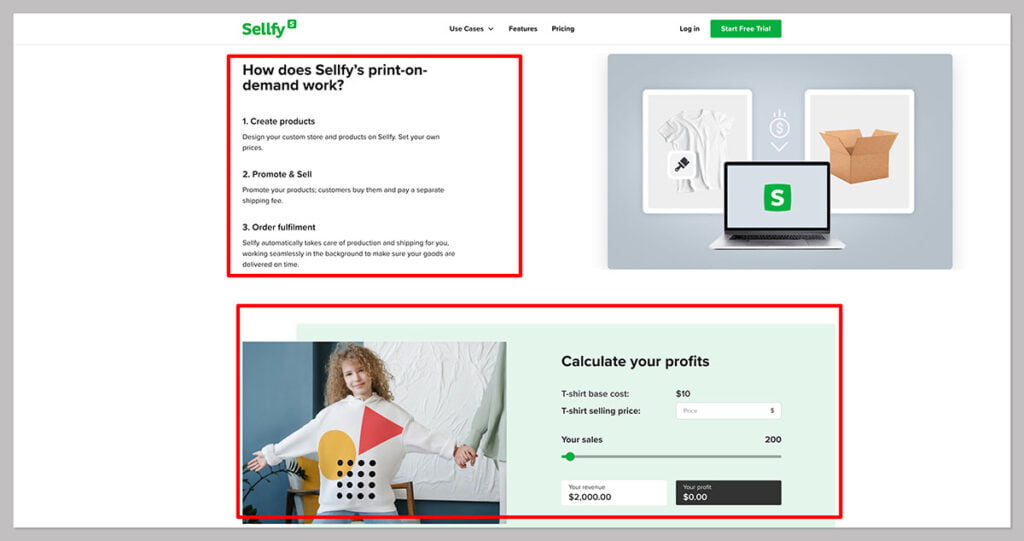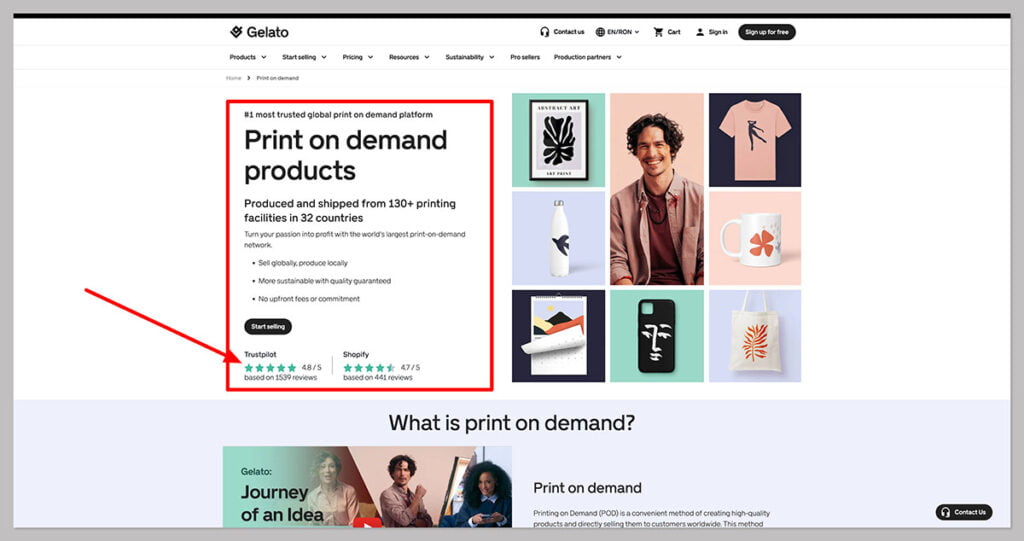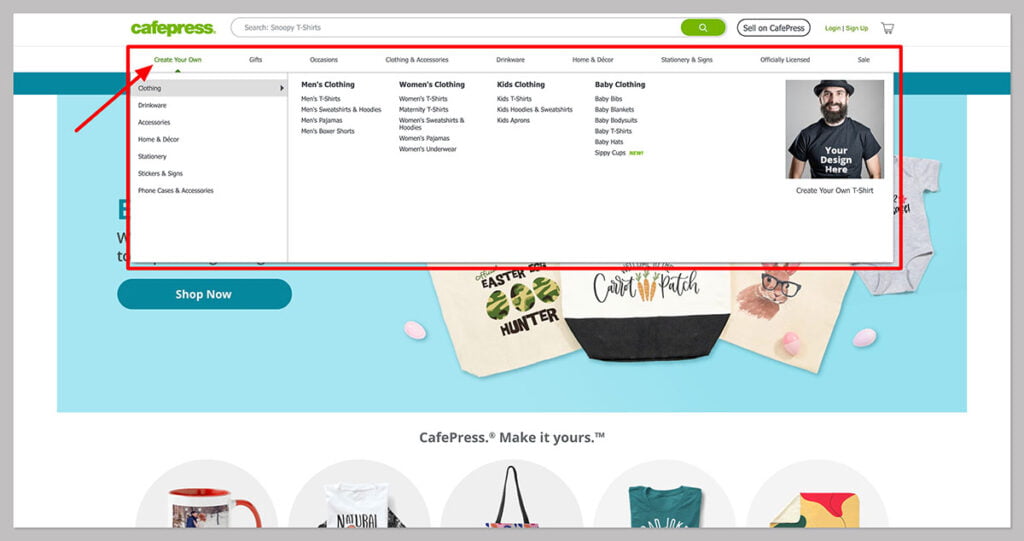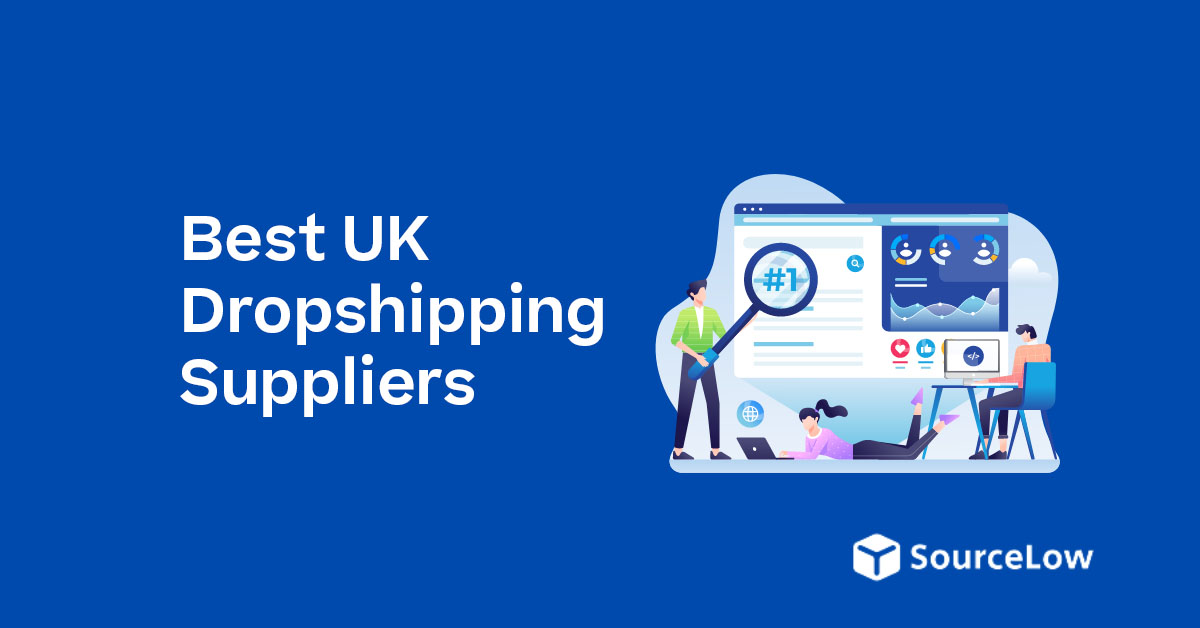Disclosure: We may earn a commission or fee from some of the links in our content. However, this does not affect our recommendations. Learn more.
If you’re looking for the best Redbubble alternatives to help boost your income as a designer, creator, or ecommerce entrepreneur, you’re in luck.
There are dozens of websites like Redbubble out there, where you can sell custom products through a marketplace.
Plus, there are also various other ways to get started with your POD journey, using print on demand platforms and apps to sell items through your own online store.
As dropshipping experts, and site builders, we’ve had the opportunity to experiment with many of these tools.
Today, we’re going to distil all of our knowledge about print on demand solutions into a single list, showcasing the best Redbubble alternatives for evolving entrepreneurs.
Best Redbubble Alternatives
What is Redbubble? (The Basics)
Redbubble is a print on demand company and online marketplace selling custom products to consumers worldwide.
Created in 2006, in Melbourne, Australia, the site was designed to give artists and creators an opportunity to sell their creations with minimal risk, complexity, or cost.
With Redbubble, you don’t need to design or store your own products, handle order fulfillment, or even build and manage your own online store.
Instead, you simply upload your unique designs to one of Redbubble’s white label products, and list them on the marketplace.
Customers can then choose the design they want (and even customize them with different colored garments), and pay Redbubble to send the item to them.
Redbubble handles the fulfillment process, partnering with global shipping services, and you earn artist royalties for every sale.
It’s one of the easiest ways to start selling products, without having to run your own ecommerce platform or digital storefront.
Why Use a Redbubble Alternative?
While Redbubble is a popular print-on-demand marketplace, with more than 70,000 creators selling products through the platform worldwide, it’s not the ideal option for everyone.
There are a few reasons you might want to consider an alternative.
For instance, websites like Redbubble don’t give you the option to build your own brand, or build strong relationships with your target audience.
When you’re selling through a marketplace, you’re limited in how much you can scale your business.
Artist platforms also only give you a commission from your earnings, rather than giving you full control over your profit margins.
An alternative print on demand provider can give you more scope to grow, by integrating with an online store or another marketplace (like Amazon, Etsy, and Ebay).
They also allow you to avoid some of the challenges of competing with hundreds of other creative community members.
Additionally, using an alternative to Redbubble means you may be able to access a wider range of products, unique and eco-friendly printing options, branded packaging options, and more.
You might even find the quality of the products created are much better from other print-on-demand providers.
The Best Redbubble Alternatives for 2024
We chose the following Redbubble alternatives based on their product selection and quality, commitment to customer service, design tools, printing methods, and pricing.
We also looked at ease of use, scalability (via e-commerce integration), and flexibility.
We’ve chosen some websites like Redbubble (POD marketplaces), as well as some alternatives for companies in search of an alternative way to sell print-on-demand products.
Not only are these some of the best alternatives to Redbubble, but they’re also some of the best print-on-demand website options, apps, and vendors available.
1. Printful

Printful is one of our favorite print on demand solutions, and the option we recommend to many ecommerce vendors.
Not only does it offer fantastic design tools (with AI features), and a huge range of products from apparel to home décor, but the product quality is fantastic. In fact, only around 0.24% of Printful products are ever returned.
Printful offers a huge range of printing options, works with leading logistics providers to ensure fast shipping, and even offers “express shipping” options.
What’s more, it integrates seamlessly with a range of platforms for online selling, including ecommerce platforms like Wix and Shopify, marketplaces, and social media channels.
Pricing
You can use Printful for free, and pay only for the base cost of your goods, shipping, and other premium services you might need (such as product photography).
However, there are also some great membership options to consider. Both memberships are free to access if you’re earning a certain amount of revenue per year ($12k for Growth, and $60k for Business).
The Growth membership, however, is also available via a monthly fee of $24.99, and includes access to discounts on virtually every type of product, shipping, and customization options.
Pros
- Excellent and intuitive design tools
- Incredible range of high-quality products
- Fast shipping with shipment guarantees
- Integrations with a huge range of platforms
- Fantastic eco-friendly printing options
Cons
- Base product costs can be expensive
- Customer support is sometimes slow
2. Printify

Like Printful, Printify is one of the best Redbubble alternatives for companies in search of scale. Instead of asking you to sell through a marketplace, it integrates with a range of ecommerce platforms and tools.
Plus, you can also choose to create a Printify “pop-up shop” for free. You can create a huge variety of products, from hoodies to custom t-shirts and canvas prints.
Printify offers AI-powered design tools, including an AI image generator, as well as more than 850 products to choose from in a host of categories.
Instead of producing products in-house, Printify also works with a huge range of global print partners, so you can choose the supplier that’s right for you based on their products, reputation, shipping times, and more.
Pricing
Once again, you can get started with Printify for free, and access all of the design tools, products, and customization options.
You will still pay for the base price of your products and shipping, however.
If you want to access extra features, such as discounts on your orders, Printful offers a premium plan for $24.99 per month, and a custom-priced plan for enterprise companies.
Pros
- Powerful AI-driven design tools
- Huge selection of affordable products
- Pop-up shop creation for beginners
- Excellent discounts on premium plans
- Good range of integration options
Cons
- Product quality can vary (based on supplier)
- Shipping times can be slow
3. Sellfy

Sellfy is an interesting alternative to Redbubble. More than just a marketplace, or a POD supplier with ecommerce integrations, it’s an all-in-one ecommerce platform, with integrated print on demand.
You can use Sellfy to build an impressive online store, without any coding knowledge. Plus, there are no transaction fees to worry about on any of your sales.
Sellfy includes access to custom billing schedules and subscriptions, payment processing capabilities, and a host of marketing features to increase conversions.
You can use the integrated design tools and print on demand services to sell custom products. Plus, you can sell a range of other items too, from digital downloads to dropshipping products and more.
Pricing:
Sellfy has no free plan, but it does offer a 30-day money back guarantee on all of its subscriptions.
Plans start at $19 per month for companies with up to $10k in sales per year.
This plan also includes unlimited products, digital products, subscription products, email marketing and more.
More expensive plans, starting at $49 per month come with cart abandonment and product upselling tools, affiliate marketing features, and the option to remove “Sellfy” branding from your store.
Pros
- Integrated print-on-demand and website builder
- Included marketing tools
- Excellent encryption and security
- Fantastic cart abandonment capabilities
- Easy to use for beginners
Cons
- Limited integrations and apps
- Sellfy branding on the cheapest plan
4. Zazzle

Zazzle is one of the top websites like Redbubble, that allows you to sell through an existing online marketplace.
It’s essentially an artist community, where creators can upload their designs to various custom products, including clothing, art prints, stickers, merch and more.
You can list your designs on the platform, and instantly access millions of customers.
Plus, unlike some Redbubble alternatives, Zazzle gives you multiple ways to make money.
You can set your own royalties on the platform for your creations, and manufacture products for other companies. Or you can join the Zazzle associate program.
Although Zazzle is located in the US, it does offer global shipping through a range of partnerships with logistics companies.
Pricing
Creators can join Zazzle’s marketplace for free, and access all of the design tools and customizable products.
You also don’t pay for the base cost of your products or shipping, like with Redbubble, but this also means you only make a “commission” for each sale.
Pros
- Excellent branding and customization options
- Wide range of unique products
- Complete control over markup and royalties
- Global fulfillment through various partners
- Convenient design tools
Cons
- Quite a competitive marketplace for beginners
- No integrations with external tools
5. Gelato

Gelato is one of the world’s most reliable print-on-demand platforms, with production centers in 32 countries.
Through integrations with ecommerce platforms and other marketplaces, it allows companies to sell globally, while still maintaining fast delivery speeds with local producers.
With Gelato, you get excellent design tools, fantastic customer service, and plenty of great products.
In fact, Gelato goes above and beyond to ensure every product created is fantastic, with state-of-the-art printing tools, sustainably sourced materials, and eco-friendly processes.
You can even access custom embroidery options for high-quality apparel items. Gelato integrates with a range of store options, including Squarespace, WooCommerce, Shopify, Etsy, and BigCommerce.
Plus, it has tools to help you choose the best pricing for your products.
Pricing
Like many Redbubble alternatives, Gelato offers a generous free plan, with complete access to its fulfillment network, design editor, and integration options.
Paid plans start at $24 per month and give you access to premium mockup tools, shipping discounts, and various additional pricing options.
There’s also a “Gold” plan with a dedicated success manager, and an enterprise “Platinum” plan, which gives you fixed rate shipping costs.
Pros
- Eco-friendly and sustainable processes
- Excellent design, pricing, and research tools
- Low-cost fast shipping in various locations
- Fantastic customer service and support
- High-quality products in a range of categories
Cons
- Limited branding options on some plans
- Fewer integrations than some alternatives
6. CafePress

CaféPress is another of the top websites like Redbubble which offers access to a thriving online marketplace.
You don’t need your own website or ecommerce store to get started, instead you simply add your designs to the white-label products already available on the platform.
Whenever you make a sale, you get a “royalty” for your design.
CafePress has plenty of excellent product categories to choose from, including leggings, sweatshirts, t-shirts, home décor, and more.
Plus, because it has fulfillment locations in the US and Europe, CafePress can offer relatively fast fulfillment times compared to Redbubble.
It also has very easy-to-use design tools and scalable royalty programs (so you earn more, the more you sell).
Pricing
Signing up for CafePress as a creator is completely free. Like with Redbubble, you don’t pay anything upfront, and there are no fees for your products or shipping.
However, you do only earn a royalty from your sales, which can make it difficult to scale. Fortunately, your royalty earnings can increase the more you sell on the platform.
Pros
- Rapid production in just a few business days
- Competitive pricing for various products
- Very easy to use platform for beginners
- Various branding options
- Quick shipping in the US and Europe
Cons
- Product quality can sometimes vary
- Limitations on profit margins
7. Fine Art America

Fine Art America is an artist community platform, where creators and photographers can sell original art and designs to other companies and consumers.
Buyers can choose to have the art printed onto a range of products, from yoga mats to wall art.
The site has an excellent reputation for being home to some of the best independent artists in the world, so it’s great for building your reputation.
Additionally, because it has fulfillment partners all over the world, including in the US, it’s great for getting products to your consumers fast.
The platform will even help you to promote your products, by “featuring” certain artists on the home page of the store. However it can still be difficult to stand out from the competition.
On the plus side, you can integrate with tools like Shopify to increase your potential sales channels.
Pricing
You can access most of the features on Fine Art America as a creator free of charge. This will allow you to upload and sell up to 25 pieces.
However, if you want more exposure and additional sale opportunities, there’s a premium plan for $30 per month. This plan also allows you to upload an unlimited number of pieces to the site.
Pros
- Integrations with other sales channels
- Control over your profit margin
- High-quality print on demand products
- Fantastic promotional tools for subscribers
- Access to a huge online audience
Cons
- Not many analytical or reporting tools
- Lots of artists to compete against
8. Society6
If you’re looking for websites like Redbubble that center around a marketplace experience, Society6 is an excellent choice.
It’s home to more than 300,000 independent artists already, located in regions worldwide.
With Society6, you can add your designs to a huge range of products, from phone cases and tech accessories to home décor and wall art.
Society6 takes extra steps to ensure all of its products live up to customer expectations, so you can guarantee excellent quality. The company also delivers products relatively quickly to locations all over the globe.
You also get to control how much you sell your products for, but only if you’re on one of the site’s paid plans.
Pricing
Society6 has a free plan that allows you to sell 10 designs, create a custom artist shop, and ship to customers worldwide. However, you can only earn 10% of your net sale.
Paid plans start at $4.99 per month, and allow you to sell 100 products and set your own prices.
There’s also a more advanced plan for $12.99 per month which comes with sales analytics, and 20% discounts on your products.
Pros
- Straightforward platform for beginners
- Excellent existing audience to increase sales
- Fantastic worldwide shipping
- Help dealing with customer returns and complains
- High-quality products
Cons
- Limited profit options on the free plan
- Basic analytic and reporting tools
Choosing the Right Platform for Your Needs
All of the Redbubble alternatives outlined above were chosen because of their exceptional features, wide selection of products, and potential for growing businesses.
However, if you’re struggling to make the right choice for your company, here are a few things to consider:
- Marketplace or App? Are you looking for websites like Redbubble, that allow you to sell products through an existing marketplace, or do you want a print on demand app and platform that can integrate with the tools you already use for online selling?
- Product variety and quality: Does your chosen vendor offer the right selection trending print-on-demand products to suit your target audience? How do you know the product quality is up to your standards, and can you order samples to double check?
- Order fulfillment options: How many logistics and shipping partners does your company work with? Do they have fulfillment centers located in the right regions worldwide? Can they offer express shipping options, and do they give you order tracking tools?
- Design tools: How easy is it to customize your chosen products with your unique designs and patterns? Does the platform offer innovative AI-driven design tools and mockup generators? How many print on demand production methods do they offer?
- Pricing: How much can you expect to pay to use the service? Think about the base cost of the products, the shipping fees, and any monthly subscription fees you’ll need to pay. Also consider whether you’ll need to pay extra for extensive customer support.
It’s also worth thinking about how you can maximize the revenue you earn from each platform.
For instance, a vendor that offers a wide range of low-cost and high quality products should help you to generate higher profit margins.
However, you could also look for tools that integrate with marketing platforms for promotion, or multiple sales channels for omnichannel sales.
The Future of Print-on-Demand and Artist Empowerment
While we’ve covered some of the most valuable Redbubble alternatives above in 2024 so far, it’s worth remembering that the market is constantly shifting.
We’re at a crucial turning point in the print on demand landscape, as technology continues to evolve, the ecommerce market expands, and buyer preferences change.
Here are some of the major trends that you should consider when launching your print on demand business, and choosing your vendor in 2024 and beyond.
Platforms Focus on Artist Empowerment
The creator economy is transforming the way we live and shop in the modern world.
Artists, innovators, and influencers are uncovering new ways to monetize their content and creations, using strategies like print on demand.
Unfortunately, in the past, many print-on-demand sites haven’t given artists the best tools to facilitate growth. Though they helped companies start companies with minimal upfront costs, it was often tough to grow.
Now, however, these platforms are evolving. We’re seeing the rise of marketplaces with innovative marketing tools, pop-up store creators, and other unique features designed to support artists.
What’s more, many marketplaces are giving creators more control over their profit margins, sales strategies, and future growth.
Product Diversification
Apparel still dominates the print on demand market in 2024, with a share of around 29.7%. However, evolutions in printing technology are giving companies new opportunities to discover different products and new options.
We’re seeing a rise in the number of businesses offering access to customizable home décor, tech accessories, and premium products.
There’s also a growing focus on sustainable products, made with eco-friendly printing methods and materials, as consumers become more ethical in their purchasing decisions.
Today, 67% of consumers say they consider the sustainability of a product before making a purchase.
Among younger generations, demand for sustainability is even greater, so if you’re targeting millennials and Gen Z in your customer base, it’s worth looking at sustainability.
Intelligent Tools and Advanced Automation
Another major trend in the POD landscape today is the rise of ever-more intelligent and intuitive tools, designed to help companies grow at lightning speed.
POD vendors are giving companies more ways to automate tasks like order tracking and processing, price evaluation and stock updates.
Plus, they’re investing in artificial intelligence to help streamline the production journey. Printful has its own AI tools that can enhance the quality of the images you upload to your custom products.
Printify has a tool that can create unique images based on text-based prompts. These innovative tools will help creators to accomplish more with less in the years ahead.
Choosing the Ideal Redbubble Alternative
Hopefully, this guide has given you a behind-the-scenes view of some of the best Redbubble alternatives, perfectly suited to growing brands in 2024.
Whether you’re looking to launch a new business on a simple marketplace platform, or you want to leverage the support of a vendor that supports an omnichannel sales strategy, there’s something for everyone.
Even better, since many of these platforms and solutions offer free demos and plans, you can start experimenting with their tools without any risk to your business.
If you need more advice on choosing the best sites for POD in 2024, check out our other guides on this blog.
We’ve reviewed plenty of other amazing options from Spreadshirt and Threadless to TeeSpring (Spring), and Teepublic.
You can also reach out to ecommerce growth consultancy team for tips on everything from choosing the best retail price for your products, to implementing marketing campaigns.



